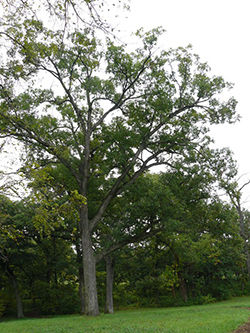
| Home | Source Reduction | Friends of Green Friends | Newsletters |
| Gardening | Resources | What You Can Do | Embracing The Trees |
|
Chicagoland ETT Tree Planting Guidelines |
 White Oak (Quercus alba) the Official State Tree of Illinois. |
Good Species to Plant for Our Changing ClimateWhite Oak Quercus alba (USDA Hardiness Zone 3-9) White oak, native to North America, is a massive, long-lived stately tree with wide spreading horizontal branches and wine-red fall color. This native tree provides shade for larger landscapes and parks. This species is native to the Chicago region.
Swamp White Oak Quercus bicolor (USDA Hardiness Zone 3-8) Swamp white oak, native to Northeastern North America including Chicago, is a striking tree with attractive peeling bark, which is especially prevalent on young trees. The lustrous, lobed leaves have a two-tone appearance, dark green on top with a silvery-white underside. Fall color is an orange-gold to yellow in mid-autumn. An excellent shade tree for any landscape.
Northern Red Oak Quercus rubra (USDA Hardiness Zone 3-8) Northern red oak is a Midwest native and is one of the faster growing oaks for the home landscape. The leaves are handsome throughout the year, emerging pinkish-red, turning lustrous dark green in summer, and changing to russet-red to bright red in autumn. Its tolerance of salt and air pollution makes it a good tree for more exposed areas.
Bur Oak Quercus macrocarpa (USDA Hardiness Zone 3a-4) The stately bur oak, native to the Midwest, is a great choice as a shade tree and for specimen plantings in parks, spacious yards, and other large areas. Its massive trunk has gray to brown furrowed bark and its branches bear lustrous dark green leaves that turn yellow-brown in fall. Large acorns with fringed caps attract birds and small mammals.
Red Maple Acer rubrum (USDA Hardiness Zone 3-9) Red maple is a widely adaptable, large tree common to the woods of eastern North America. A red tinge can be found in its flowers, twigs, and seeds, but it is most notable for the scarlet of its leaves in fall. Red maple needs plenty of room for its dense, spreading root system. Fall color can be yellow rather than red, so select a cultivar bred for red fall color. This species is native to the Chicago region.
Bald-Cypress Taxodium distichum (USDA Hardiness Zone 4a-11) This stately conifer, native to the Midwest, is often found in groupings in parks and larger spaces, along streets, and around lakes. Unlike most cone-bearing trees, bald-cypress loses its needles each winter and grows a new set in spring. The russet-red fall color of its lacy needles is one of its outstanding characteristics. Hardy and tough, this tree will adapt to a wide range of soil types, whether wet, dry, or swampy.
Redbud Cercis canadensis (USDA Hardiness Zone 4-9) In April and May, many neighborhoods are brightened by the purplish-pink flowers lining the dark branches of redbuds before their leaves open. This Chicago-area native plant evolved in the understory and along the edges of forests. It works especially well among evergreens that contrast with its color and shelter it from intense sunlight. This species is native to the Chicago region.
Chinese Chestnut Castanea mollissima (USDA Hardiness Zone 4-8) Chinese chestnut is resistant to chestnut blight which has almost wiped out the American chestnut. This non-native species produces spikes of creamy white flowers in summer. The edible nuts develop in sharp, spiny husks. Not native to Illinois, but there are many cultivars of Chinese Chestnut crossed with American Chestnut.
Pawpaw Asimina triloba (USDA Hardiness Zone 4-9) Whether planted in full sun or part shade, the pawpaw tree, native to the Midwest, works well as a specimen or can be useful as a screen. Nodding, dark purple flowers in the spring, elongated edible fruit in the summer, and a yellow to yellow-green fall color add to the appeal of this small understory tree. Pawpaws may be difficult to find in nurseries. This species is native to the Chicago region.
|
Nurseries· Mason State Tree Nursery (Illinois State Nursery) · Natural Garden Natives (St. Charles, IL) · Byron Native Nursery (St. Charles, IL) · Green Guerilla Landscaping (Elgin, IL) · Pizzo Native Plant Nursery (Leland, IL) · Possibility Place Nursery (Oregon) Soil and Water Conservation Districts Other Sources Stark Bro's Nurseries & Orchards (a horticultural company based in Louisiana, Missouri, that specializes in growing and selling fruit trees to home gardeners and orchardists) Tree-planting Groups or Non-profits for VolunteeringForest Preserve District of Kane County Citizens for Conservation (focused on prairie restoration) National Forest Foundation (an American non-profit organization, was created by Congress in 1992 to be the official non-profit partner of the United States Forest Service) Tree experts within the Amma community:
Lalitha Meyer |
| Home | Source Reduction | Friends of Green Friends | Newsletters | Resources | What You Can Do | Embracing The Trees |
For more information, e-mail info@greenfriendsna.org |
||||||